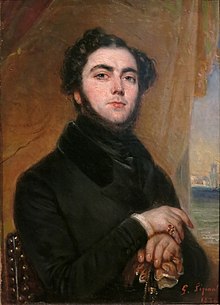Eugène Sue
| Eugène Sue | |
|---|---|

Portrait of Eugene Sue (1835) by François Gabriel Lepaulle
|
|
| Born | Joseph Marie Eugène Sue January 26, 1804 Paris |
| Died | August 3, 1857 (aged 53) Annecy-le-Vieux, Kingdom of Sardinia |
| Resting place | Cimetière de Loverchy, Annecy |
| Occupation | Novelist |
| Language | French |
| Nationality | French |
| Education | Lycée Condorcet |
| Period | 1830–1857 |
| Literary movement | Romanticism |
| Notable works | The Mysteries of Paris |
| Notable awards | Legion of Honour |
Marie-Joseph "Eugène" Sue (French pronunciation: [ø.ʒɛn sy] (26 January 1804 – 3 August 1857) was a French novelist. He was one of several authors who established the genre of the serial novel with his very popular and widely imitated The Mysteries of Paris, which was published in a newspaper from 1842 to 1843.
He was born in Paris, the son of a distinguished surgeon in Napoleon's army, Jean-Joseph Sue, and is said to have had the Empress Joséphine for godmother. Sue himself acted as surgeon both in the 1823 French campaign in Spain and at the Battle of Navarino (1828). In 1829 his father's death put him in possession of a considerable fortune, and he settled in Paris.
His naval experiences supplied much of the materials of his first novels, Kernock le pirate (1830), Atar-Gull (1831), La Salamandre (2 vols., 1832), La Coucaratcha (4 vols., 1832–1834), and others, which were composed at the height of the Romantic movement of 1830. In the quasi-historical style he wrote Jean Cavalier, ou Les Fanatiques des Cevennes (4 vols., 1840) and Latréaumont (2 vols., 1837). His Mathilde (1841) contains the first known expression of the popular proverb "La vengeance se mange très-bien froide", lately expressed in English as "Revenge is a dish best served cold".
He was strongly affected by the Socialist ideas of the day, and these prompted his most famous works, the "anti-Catholic" novels: The Mysteries of Paris (Les Mystères de Paris) (published in Journal des débats from 19 June 1842 until 15 October 1843) and The Wandering Jew (Le Juif errant; 10 vols., 1844–1845), which were among the most popular specimens of the serial novel. These works depicted the intrigues of the nobility and the harsh life of the underclass to a wide public. Les Mystères de Paris spawned a class of imitations all over the world, the city mysteries.
...
Wikipedia
